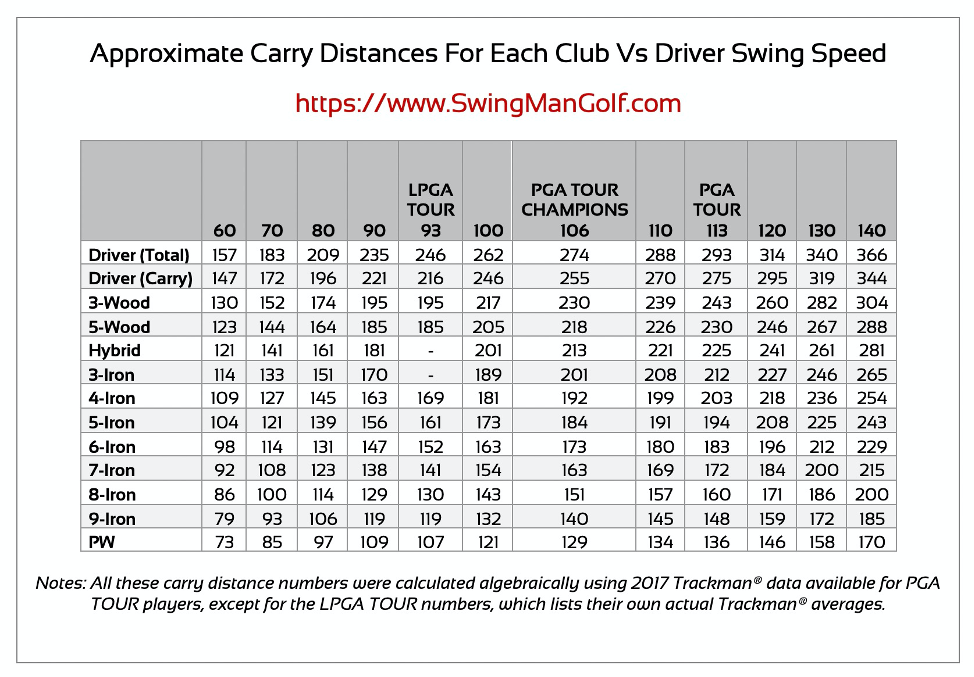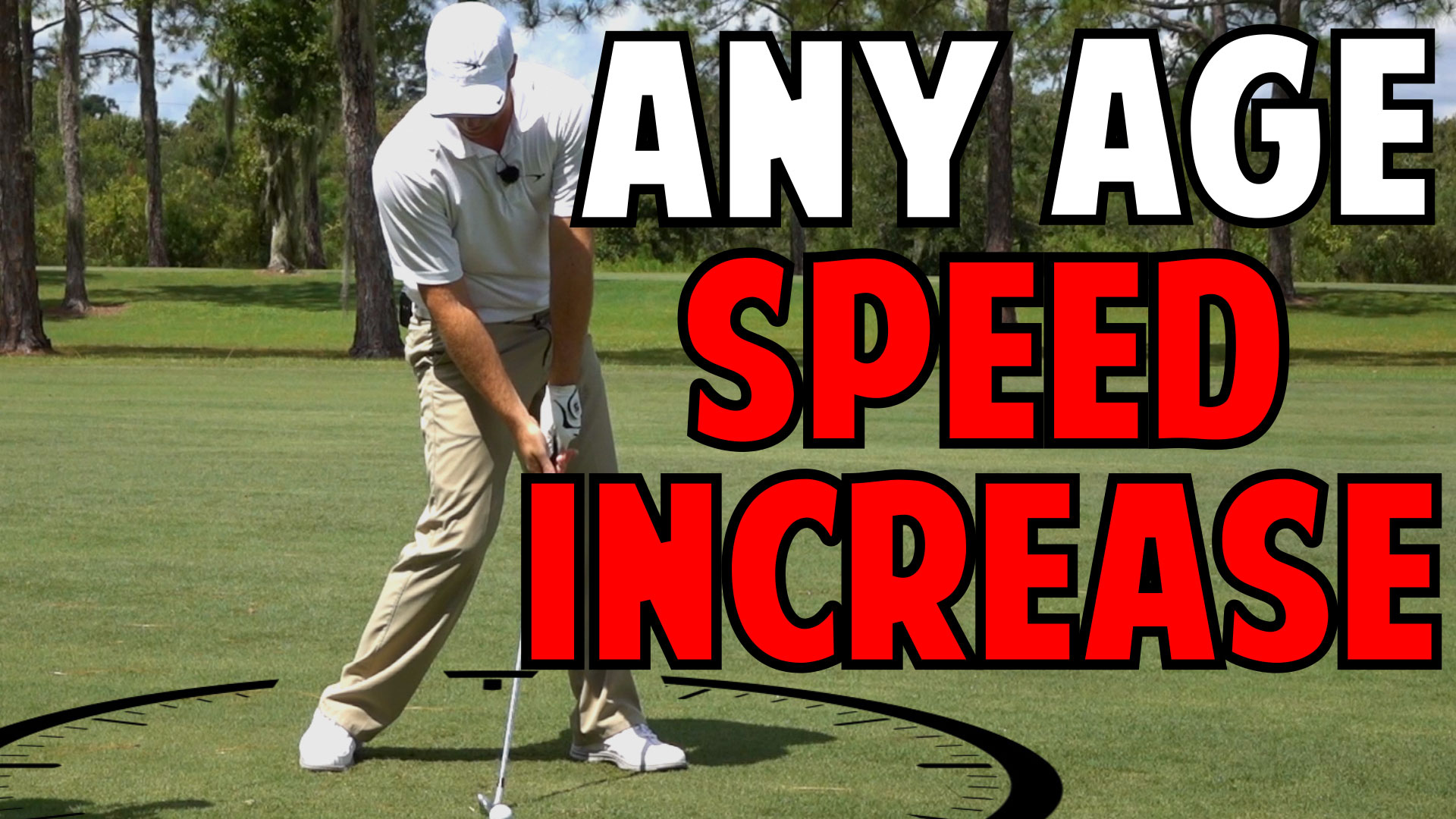- 7 Iron Swing Speed Chart
- Average Clubhead Speed By Age Calculator
- Average Clubhead Speed By Age Percentile
This 2.55 yards per mph of clubhead speed is what we can call the “driving efficiency.” While some golfers can produce higher efficiency (notably LPGA tour players who tend to be more efficient than their male counterparts), this would be considered very high for most golfers. The average driver clubhead speed on the PGA Tour is 113 MPH and 94 MPH on the LPGA Tour with even faster ball speed which indicates that they will require less loft, typically a 9.5 degree loft for their driver (especially the longest hitters on tour). Best Distance Driver Loft. So that is how things look for professionals on tour but for you. Many golf retail stores and pro shops can take this measurement. Otherwise, the speed can be estimated based on the club that you hit from a distance of 150 yards. If you use a 3-iron or wood, your swing speed is probably less than 60 mph; a 4-iron is 60-75 mph; a 5-iron is 75-84 mph; a 6- or 7-iron is 84-93 mph; and an 8- or 9-iron is over 93 mph.
Golf club head speed is the biggest determinant of how far a golf ball will travel.
Many golf professionals are able to generate high club speeds through their form and method of striking the ball.
Although the optimum method to measure golf club speed is through using technology at a golf training or practice facility, many golfers do not have the access or money to have their club speed measured. If you need to purchase new golf clubs or other related equipment, however, you can estimate the golf club speed.

Step 1
Hit 20 golf balls with your driver at your local practice range and record the distance the drives carried. Discount any drives that you mishit significantly.

Step 2
Step 3
Subtract a “roll factor” from the drive average to determine the distance of carry for your drives. A common factor that you can use for this part of the calculation is to subtract 5 percent of the drive average.
Step 4
Divide the distance by 1.75, which will provide the ball speed at impact. If you carry the ball 230 yards in the air, the ball speed will be just over 130 miles per hour.
Step 5

Divide the ball speed by 1.5 to get the estimated swing speed for your drive. Alternatively, you can divide the carry distance by 2.3 to estimate the swing speed at impact, but the result will not be as accurate.
Chart Showing Golf Club Distances
7 Iron Swing Speed Chart
This chart lists the expected average golf club distances for each club based on varying swing speeds for men and women. The first number is for lower-speed swingers (less than 85 mph with the driver), followed by medium (86-104 mph) and high-speed (105+ mph) swingers. These figures may vary based on the golfer’s skill level, swing characteristics and other factors.
| Men Yards slow / med / fast | Women Yards slow / med / fast | |
| Driver | 190 / 220 / 260 | 150 / 175 / 215 |
| 3-wood/1+ hybrid | 170 / 200 / 225 | 125 / 150 / 180 |
| 5-wood/2 hybrid | 160 / 190 / 215 | 115 / 140 / 170 |
| 3 iron/3-hybrid | 150 / 180 / 205 | 105 / 130 / 160 |
| 4-iron/4 hybrid | 140 / 170 / 195 | 95 / 120 / 150 |
| 5-iron/5 hybrid | 130 / 160 / 185 | 85 / 110 / 140 |
| 6-iron/6 hybrid | 120 / 150 / 175 | 75 / 100 / 130 |
| 7-iron/7 hybrid | 110 / 140 / 165 | 65 / 90 / 120 |
| 8-iron/8 hybrid | 100 / 130 / 155 | 55 / 80 / 110 |
| 9-iron/9 hybrid | 90 / 120 / 145 | 45 / 70 / 100 |
| PW/PW hybrid | 80 / 110 / 135 | 35 / 60 / 90 |
| GW/GW hybrid | 70 / 100 / 125 | 25 / 50 / 80 |
| SW/SW hybrid | 60 / 90 / 115 | 20 / 40 / 70 |
| LW/LW hybrid | 40 / 70 / 95 | 15 / 30 / 60 |
The fundamental rule of golf club distances is pretty simple: Lower = Longer. To elaborate, the lower the club number, the longer the shots.
For example, a 6-iron hits the ball father than a 7-iron, a 3-wood hits it farther than a 5-wood, and so on.
That’s the easy part. More difficult is figuring out how far you hit each club in your set. Emphasis on you.

While variations in length and loft between clubs are static, the differences from one golfer to another can be huge. In fact, the same golfer’s distances can change golf club distances over time as he becomes more skilled, stronger, older, etc.
What you really need to know is how far you hit each club right now. This is critical info, since it helps you decide which club to use for a given shot on the course. If you’re 130 yards from the flagstick, do you choose a 9-iron? A 5-iron? A 3-hybrid?
The number you’re after is carry distance, or how far the ball travels in the air, disregarding how many yards it rolls after landing. (Roll can vary greatly from course to course, or round to round, depending on the weather and firmness of the turf.)
Average Clubhead Speed By Age Calculator
It’s wise to calculate your average golf club distances with each club by hitting a series of 10 or more shots. It’s also important to know how far you hit your best shots – the ones you strike directly on the sweet spot.

There are several ways to determine how far you hit each club; combining these methods will give you the most accurate stats. Let’s examine the different tactics:
- Launch monitor: This is the most scientific and accurate way to measure your distances, though you’ll likely have to pay for the privilege. Used by clubfitters as well as teaching pros, launch monitors take a snapshot of your swing at the all-important moment of impact. Among other data points, a launch monitor will calculate your clubhead speed, the angle at which the ball leaves the clubhead (launch angle), the ball’s spin rate and its carry distance.
Many golf retail stores feature indoor hitting areas with launch monitors. Several companies sell portable units for personal use as well.
- Driving range: To measure your yardages on the range, you’ll need a facility with several flags or distance markers that are accurately measured. It’s best to hit shots from a grass surface rather than a synthetic mat, too. If you can locate a range that uses relatively new golf balls – rather than beat-up balls which don’t fly as far – so much the better.
Even with a good surface, decent balls and accurate yardage markers, you’ll have to estimate your shot distances based on how far short of or beyond the target they land. The farther the target and shot, the tougher it is to judge. Perhaps you can enlist a friend to help by noting each shot’s landing spot through binoculars or a rangefinder.
Hit at least 10 shots with each club toward a specific target and write down the yardage each ball travels. It’s a good idea to exclude your longest and shortest results before taking the average.
- On the course: When playing a round, make note of your distance to the flag or green on approach shots using the course’s fairway yardage markers, on-cart GPS units or your own hand-held GPSdevice or rangefinder . Record the club you hit for the shot, the quality of contact (i.e., good, fair, poor) and how far the shot carried. Remember, wind, rain, playing uphill or downhill and other factors can affect your distance, so it’s best to only record shots in calm conditions when you’re level with the target.
Average Clubhead Speed By Age Percentile
Once your average yardages become clear, you should notice a consistent difference in distances between clubs. For example, you might see 10-12 yards between each short iron, 12-15 between middle irons, etc… Knowing these figures is another critical factor in club selection.